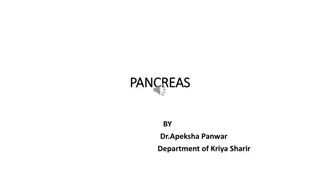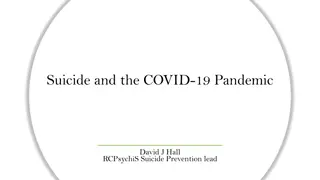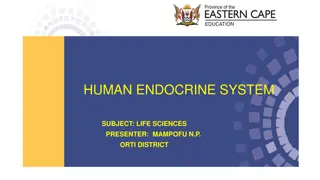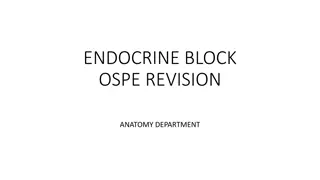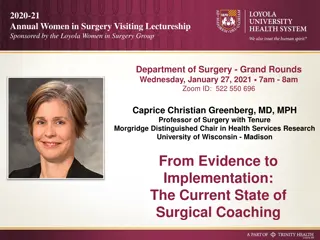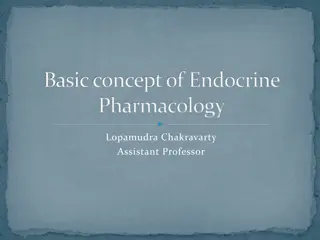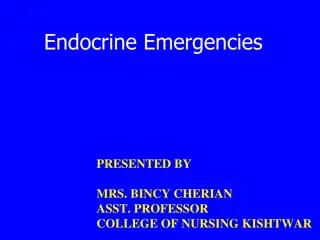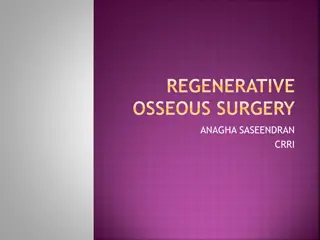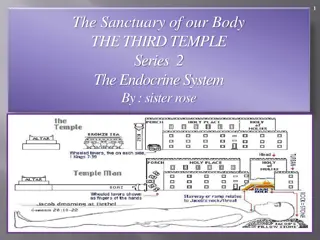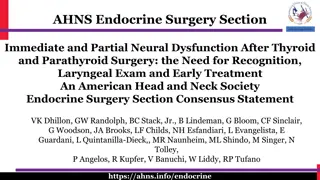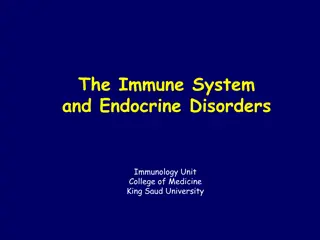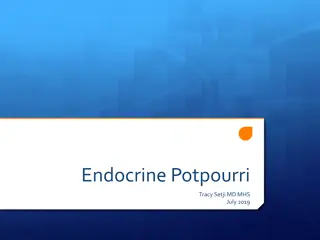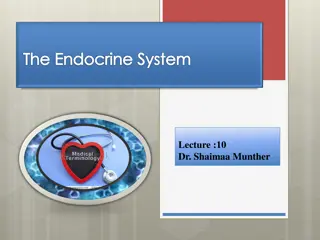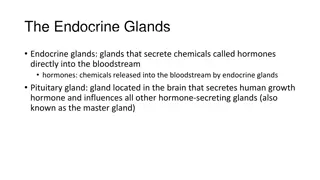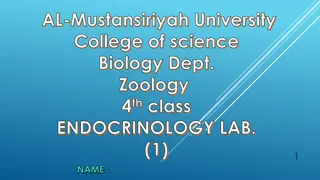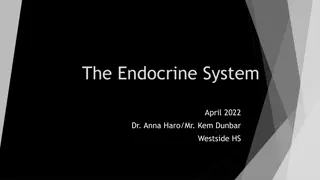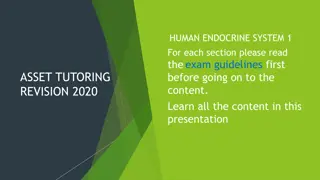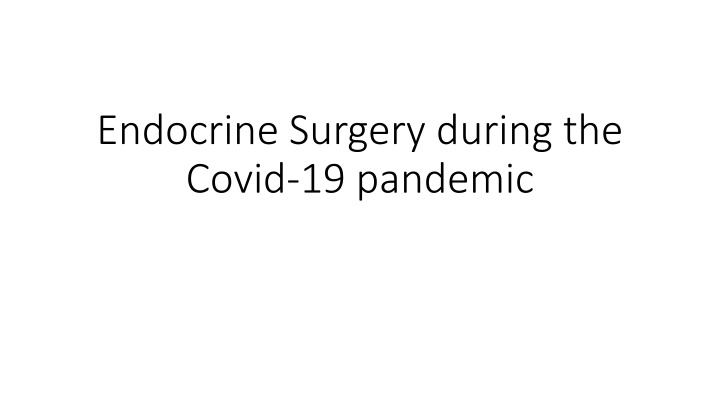
Endocrine Surgery Guidelines During the Covid-19 Pandemic
Expert opinions recommend delaying surgical treatment for endocrine conditions during the Covid-19 pandemic to ensure no negative effects on surgical outcomes. Specific risk reduction strategies, surgical prioritization, and timing guidelines are outlined to protect patients and healthcare workers. Three stages of surgical intervention based on the epidemic's status are detailed. The timing of surgeries is classified into four priority levels, emphasizing the importance of timely interventions in life-threatening situations.
Download Presentation

Please find below an Image/Link to download the presentation.
The content on the website is provided AS IS for your information and personal use only. It may not be sold, licensed, or shared on other websites without obtaining consent from the author. If you encounter any issues during the download, it is possible that the publisher has removed the file from their server.
You are allowed to download the files provided on this website for personal or commercial use, subject to the condition that they are used lawfully. All files are the property of their respective owners.
The content on the website is provided AS IS for your information and personal use only. It may not be sold, licensed, or shared on other websites without obtaining consent from the author.
E N D
Presentation Transcript
Endocrine Surgery during the Covid-19 pandemic
Endocrine Surgery during the Covid-19 pandemic These guidelines are based on expert opinions by considering factors, such as the course and biology of the disease, rather than evidence- based/best practice Delay surgical treatment No negative effect on the surgical outcome or disease process Risk reduction strategies Planning of the surgery, preparing for surgery Protecting both patients and healthcare workers Postoperative care Sisli Etfal Hastan Tip Bul. 2020; 54(2): 117 131.
Endocrine Surgery during the Covid-19 pandemic Only life-threatening emergency operations should be performed in the stage where the epidemic exceeds the capacity of the hospitals (first stage) Cancer and transplantation surgery should be initiated when the outbreak begins to be controlled (second stage) Surgery for elective cases should be performed in a controlled manner with suppression of the outbreak (third stage) Sisli Etfal Hastan Tip Bul. 2020; 54(2): 117 131.
Timing of surgeries are divided into four priority levels Level 1a: Life-threatening situations that need to be operated within 24 hours to save the patient Level 1b: Conditions that need to be operated between 24-72 hours for life-threatening conditions that may cause, such as obstruction, bleeding, local or regional infection, permanent injury/clinical harm from the progression of conditions, such as spinal cord compression Level 2: Conditions requiring elective surgical intervention and where surgery can be postponed safely for up to four weeks before a negative condition develops Level 3: Conditions in which elective surgical intervention can be postponed for up to three months without a predicted negative outcome Level 4: Conditions in which elective surgical intervention can be postponed more than three months without a predicted negative outcome British Association of Endocrine and Thyroid Surgeons (BAETS) Sisli Etfal Hastan Tip Bul. 2020; 54(2): 117 131.
Endocrine Surgery during the Covid-19 pandemic American College of Surgeons scoring system: for all elective surgical interventions, including a total of 21 factors, scored with points ranging from 1 to 5 points: Seven factors related to surgery (operating room time, estimated hospital stay, possibility of requiring postoperative intensive care, expected blood loss, probability of intubation, surgical region) Six factors related to the disease (effectiveness rate of nonoperative treatment option, risks of nonoperative treatment, effect of two weeks delay on disease outcomes, effects of two weeks delay on the difficulty and risks of surgery, effects of four weeks delay on disease outcomes, effects of four weeks delay on the difficulty and risks of surgery) Eight factors related to the patient (age, presence of lung disease, presence of obstructive sleep apnea, presence of cardiovascular disease, presence of a condition related to immune system suppression, influenza-like symptoms, contact with a person known to be COVID-19 positive in the past 14 days). The high total score, ranging from 21 to 105, is associated with worse perioperative patient outcomes, increased risk of transmission of COVID-19 to the healthcare team, and/or increased hospital resource utilization. This scoring system can enable the evaluation and planning of not only endocrine surgery but all surgeries together, especially in centers where operating room conditions are limited. J Am Coll Surg. 2020
Thyroid Surgery during the COVID-19 Pandemic Firstly, the patients should be examined for the presence of the COVID-19 symptoms. The diagnosed COVID-19 patients should be administered COVID-19 treatment primarily if they do not have an airway failure due to thyroid disease. In case of the individuals having no COVID-19 symptoms and findings, but being under the risk of viral transmission, actions should be taken in compliance with the recommendations of the relevant units if they do not have an acute airway failure due to thyroid disease. Although there are no clear guidelines in the management of patients applying for thyroid diseases, it would be appropriate to manage these patients based on the analysis of risk groups. The first approach should be determining if there is airway distress due to thyroid disease or not, while the second approach should be distinguishing benign and malignant cases. Cont. Sisli Etfal Hastan Tip Bul. 2020; 54(2): 117 131.
Thyroid Surgery during the COVID-19 Pandemic: Benign Conditions (1) Large Goiters: causing a tracheal deviation and mild compressive symptoms, it would be appropriate to avoid surgery Surgery should be considered in a rapid growth or causing acute airway distress. Mostly, removing out the lobe, causing compression on the airway, with the isthmus (hemithyroidectomy) would be sufficient, in the absence of intraoperative suspicion of malignancy. Sisli Etfal Hastan Tip Bul. 2020; 54(2): 117 131.
Thyroid Surgery during the COVID-19 Pandemic: Benign Conditions (2) Fine Needle Aspiration Biopsy (FNAB) Proven Benign Thyroid Nodules and Graves Disease: They can be managed in the same way as they were before the pandemic If any severe complication, such as recurrent neutropenia/agranulocytosis or liver failure, occurs in a patient receiving anti-thyroid therapy for Graves disease, surgical intervention may be considered after managing these complications. British Thyroid Association (BTA) states that the operation is safe and acceptable in most cases Covid 19 because patients with uncontrolled thyrotoxicosis may have a higher risk of thyroid storm due to COVID- 19These patients can be operated after 5-7 days of preoperative rapid preparation (with a beta-blocker, iodine solution and dexamethasone) Sisli Etfal Hastan Tip Bul. 2020; 54(2): 117 131.
Thyroid Surgery during the COVID-19 Pandemic: Benign Conditions (3) Asymptomatic Incidentally Discovered Thyroid Nodules (with Physical Exam or Ultrasound (US)): An enlarging neck mass with concern for anaplastic thyroid carcinoma (ATC) or lymphoma should be biopsied as soon as possible. A nodule with concern for medullary thyroid carcinoma (MTC), lymph node disease that will direct surgical treatment, suspicious nodules of >4 cm and new-onset hoarseness require FNAB in less than one month. FNAB can be delayed for more than three months with suspicious nodules of 1-4 cm in size (ATA risk classification: moderate or high risk/TIRADS classification: 4 or 5) and incidental positron emission tomography- computed tomography (PET-CT) avid nodules Sisli Etfal Hastan Tip Bul. 2020; 54(2): 117 131.
Thyroid Surgery during the COVID-19 Pandemic: Malignant Conditions (1) FNA Proven Malignant Nodules (Bethesda V and VI categories): Differentiated Thyroid Carcinoma (DTC), MTC and ATC Despite a major health crisis like COVID-19, patients are concerned about their own problems, such as proven or suspected thyroid cancer. Some thyroid cancers are life-threatening and will require urgent attention while other tumors may be monitored or treated lately. In most cases, postoperative radioiodine (RAI) therapy is not urgent and can be safely delayed. DTC (ATA Low and Intermediate Risk): These patients (without compressive symptoms and signs, no apparent nodal metastasis, no voice changes) may wait 3-6 months for surgery. During this time, COVID-19 can be controlled and may pose less risk for health care workers. If an extended observation period is needed, imaging with the US once again after three months may encourage patients to delay surgery further. Intrathyroidal Papillary Microcarcinomas (PTMC) can definitely be observed. Moreover, some of these patients can be encouraged to remain under active surveillance. It should be kept in mind that US examination should be repeated with certain intervals DTC (ATA High risk): Large compressive or Loco-regional aggressive DTC (Evidence of aero-digestive tract compression, recurrent laryngeal nerve palsy due to malignancy, the rapid growth of tumor) require surgical intervention. Appropriate cross-sectional imaging (CT, Magnetic resonance imaging (MRI)) can be very helpful in determining the extension of surgery MTC: The extent of the disease should be determined using cross-sectional imaging, calcitonin and CEA levels; that can be important for the timing of the surgery. In this context, if the disease appears to be limited to the thyroid region and calcitonin levels are not high (under 400), patients can be monitored for a few months hoping for COVID-19 to be taken under control. This situation should be discussed between the surgeon and patients to make them feel more confident. On the other hand, according to BTA, MTC should be managed similarly with the usual practice. Prophylactic surgery should not be postponed if possible in pediatric MEN2 patients having a high risk of malignancy. If the surgery is deferred, the patient should be carefully monitored with calcitonin levels and US Sisli Etfal Hastan Tip Bul. 2020; 54(2): 117 131.
Thyroid Surgery during the COVID-19 Pandemic: Malignant Conditions (2) Proven Anaplastic Thyroid Cancer with FNAB or Core Biopsy: Patients with rapidly growing thyroid tumors require emergent management. The extent of the disease should be evaluated with cross-sectional imaging. If the tumor appears to be unresectable, and the patient has acute airway distress, tracheostomy or cricothyrotomy may be necessary. Otherwise, appropriate targeted therapies, such as multikinase inhibitors and external radiation therapy, should be considered Rapidly Growing Thyroid Tumors without Histological Diagnosis. The definitive diagnosis can be made easily using US-guided core biopsy. The patient should be approached as in B4a if the result is reported as ATC. If the result indicates a systemic disease, such as lymphoma, the patient should be transferred to the relevant unit for systemic chemotherapy, and the airway should be monitored closely. Sisli Etfal Hastan Tip Bul. 2020; 54(2): 117 131.
Parathyroid Surgery during the COVID-19 Pandemic Mostly evaluated in the elective operation group Asymptomatic or normocalcemic patients Surgery for Primary Hyperparathyroidism: Cancer suspicion (severe hypercalcemia, imaging-clinical findings) Serum calcium level is above 3 mmol/L (12 mg/dl) and does not fall below this level with medical treatment (hydration, furosemide, cinacalcet) Pregnant patients (should be decided together with the endocrinologist, and, if possible, operated on the second trimester) Surgery for secondary Hyperparathyroidism: Life-threatening calciphylaxis (necrosis and sepsis due to soft tissue calcifications) Development of the pathological bone fracture Surgery for Tertiary Hyperparathyroidism: Hypercalcemia that impairs renal function in the post-transplantation period. Sisli Etfal Hastan Tip Bul. 2020; 54(2): 117 131.
Adrenal Surgery during the COVID-19 Pandemic Urgent adrenalectomy Confirmed adrenal cancer diagnosis or highly suspicious masses (also including malignant pheochromocytoma) Indeterminate masses of >6 cm, especially increasing in size or hot (and nonfunctional) on PET-CT scan Benign pathologies, such as refractory Cushing s syndrome and pheochromocytoma presenting with heart failure Semi-urgent adrenalectomy Adrenal metastases: adrenal metastases is to rescan after three months and re- prioritize in case of progression. Pheochromocytoma: to block the highest degree that a patient can tolerate. Indeterminate masses of <6 cm: PET scan was recommended Cushing s syndrome with comorbidities: metyrapone was recommended for Cushing s disease with co-morbidities Postpone all elective and endoscopic surgeries Sisli Etfal Hastan Tip Bul. 2020; 54(2): 117 131.
Protective measures for operating room staff Protective equipment should include at least the N95 masks and face shields Although there are some published data showing that laparoscopy may lead to aerosolization of blood-borne viruses, this guideline reports that neither there is evidence to indicate that this effect is seen with COVID-19, or that it would be isolated to MIS procedures. Nevertheless, for minimally invasive surgery, MIS procedures, the use of devices to filter released CO2for aerosolized particles should be strongly considered. Besides the proven benefits of MIS, guideline mentions that the ultrafiltration of aerosolized particles may be more difficult during open surgery Surgical equipment used during procedures with COVID-19 positive or suspicious patients should be cleaned, separately Sisli Etfal Hastan Tip Bul. 2020; 54(2): 117 131.
Practical recommendations for laparoscopy Incisions for ports should be as small as possible not to allow for leakage around ports. CO2insufflation pressure should be minimized as much as possible and an ultrafiltration (smoke evacuation system or filtration) should be used, if available. At the end of surgery or before converting to open surgery or removal of trocars, the pneumoperitoneum should be carefully released and safely evacuated via a filtration system in case of aerosol formed during the operation Sisli Etfal Hastan Tip Bul. 2020; 54(2): 117 131.
Neuro-Endocrine Tumors Surgery during the Covid-19 pandemic All elective procedures should be postponed Life-threatening high-grade tumors Patients with hormone-active NETs whose symptoms cannot be controlled (e.g., medically refractory insulinoma) medically should undergo surgical treatment Sisli Etfal Hastan Tip Bul. 2020; 54(2): 117 131.
Preoperative Planning and Preparation in COVID- 19 Period to determine whether the patient has an infection due to SARS-CoV-2 or not all 4 below tests should be performed: taking an anamnesis and physical examination biochemical tests microbiological examinations (PCR) radiological examinations It should be kept in mind that although all these tests are normal, the Covid 19 may be present Sisli Etfal Hastan Tip Bul. 2020; 54(2): 117 131.
Preoperative Planning and Preparation in COVID- 19 Period: anamnesis and physical examination To minimize contact, patient s tests regarding his presurgical disease should be examined in advance During the interview, both the patient and doctor should use a surgical medical mask The patient s travelling history and contact history with cases of suspected/confirmed infection with COVID-19 in the last 14 days should be questioned physical examination: measuring fever and pulse The informed consent, prepared exclusively for COVID-19, should be taken except the standard surgical consent form and also it is very important to inform the patient about COVID-19
Preoperative Planning and Preparation in COVID-19 Period: biochemical tests Decreased albumin level Increased ALT, AST, and total bilirubin levels Hyponatremia Hypokalemia Hypocalcemia Increased BUN, cr, and glucose levels LDH and d-dimer which are not included in the routine preoperative examinations may increase CBC: Increased leucocytes and neutrophils Deceased lymphocytes and platelets None of these tests and findings is specific to COVID-19
Preoperative Planning and Preparation in COVID- 19 Period: Real-time Polymerase Chain Reaction(PCR) PCR test from the nasal and pharyngeal swab is the gold standard in the diagnosis of new coronavirus SARS-CoV-2 Sensitivity: 37% and 71% The most important factors affecting false-negative results are the sample, including inadequate material, type and transportation of the sample, and taking the sample in too early or late periods of infection. The health worker taking the swab should have the appropriate personal protective equipment If the test result is positive, it is recommended to repeat the test for confirmation In cases with suspected infection whose test results were negative, repeating samples with an interval of 24-48 hours is recommended Sisli Etfal Hastan Tip Bul. 2020; 54(2): 117 131.
Preoperative Planning and Preparation in COVID-19 Period: Radiologic examination Use of direct radiography and CT in diagnosis is increased due to the PCR test s sensitivity being not high enough and difficulties in reaching the test The sensitivity of direct radiography is low in the early stage of the disease or mild disease. Thus, direct radiography should not be used in patients who are considered to have elective surgery and have no symptoms since its diagnostic value is low Thorax CT has a high specificity of 93-100% and moderate sensitivity of 72- 94% Thorax CT has diagnosed existing pneumonia in 67% of COVID-19 negative cases and 94% of COVID-19 positive patients according to the PCR test result. Thorax CT which is going to be used in the preoperative evaluation should be taken in the last 24 hours before surgery
Preoperative Planning and Preparation in COVID- 19 Period:Endoscopic vocal cord examination Normally recommended for preoperative evaluation before thyroid or parathyroid surgery, should not be routinely performed Vocal cord examination should be performed only in selected cases with hoarseness and appropriate personal protective equipment should be used during the examination In the postoperative period, the laryngeal examination should only be performed on patients with recurrent laryngeal nerve injury or loss of signal during intraoperative neuromonitoring or if further contralateral surgery is planned in the near future.
Preoperative Preparation of the Operation Room (1) Protect patient and the healthcare workers from the infection and to prevent the contamination of the hospital environment from saving other patients and hospital staff In the period of COVID-19 pandemic, all patients should be considered suspicious, so disease and infection control measures should be taken. Suspicious or confirmed COVID-19 cases should be scheduled at the end of the list if possible This organization should be planned meticulously beginning with the transfer of the patient from the surgical ward to the OR. The patient should be transferred with a surgical mask. It is important that this transfer is carried out as quickly as possible and with minimal contact with the hospital environment and other people. An elevator reserved for the transfer of COVID-19 positive patients should be used if needed and immediate disinfection is performed after the transfer An OR located away and isolated from the general operating complex must be reserved for infected patients. The room s location is planned as the shortest way to the transfer gate of the operating complex, which is advised to be a separate gate to minimize contamination. The OR reserved for patients with COVID-19 should be marked visibly for everyone and should not be used for any other purpose.
Preoperative Preparation of the Operation Room (2) It is obvious that intubation for general anesthesia bears the aerosol effects Designing the OR for infected patients as negative pressure rooms is important to prevent the halls and other parts of the operating complex from contamination Still, most of the ORs are equipped with positive pressure. It is advised to convert at least one OR to a negative pressure room. Positive pressurization and air conditioners must be closed if a negative pressure room is not possible Maintaining the OR gate closed except for mandatory needs, especially strictly after intubation and extubation for 10 minutes, will help protection of viral spread outside the OR. Providing at least 25 times/hour circulation of OR air, HEPA filters will remove more than 99% of the viral load Discontinuation of positive pressure for at least 20 minutes after the deport of the patient from the room is beneficial Adding checklist specific to COVID-19 to the routinely used checklist before surgery is recommended because it minimizes the risk of errors or adverse events
Preoperative Preparation of the Operation Room (3) All the equipment and surgical items are prepared in the room before the patient is accepted to the OR. The trolleys for anesthesia are kept outside the room and all the drugs, medications and equipment that are needed by anesthesia are kept in the OR in a disposable tray. This provides prevention of contamination of all the trolley and material transfer during surgery. All the unnecessary equipment and devices must be taken out of the OR. Surgery of COVID-19 infected patients must be planned to be performed as quickly as possible with the least number of surgical staff. The surgical staff who will be in charge during the surgery should be predetermined, recorded and allowed to enter the room. Unless there is an emergency, the team should never be changed during the surgery. Unnecessary mobility should be restricted. The adequacy of laminar flow and function of high-efficiency filters are periodically controlled by technicians. Consultations and planning of the operation between the surgery and anesthesia departments should be made in advance to ensure minimal time consumed with the patient. The surgical team should use suitable, tested personal protective equipment (PPE) during the surgery of confirmed or suspected COVID-19 patients PPE should be available outside the OR and worn before entering the OR Personal protective equipment consists of the mask-N95, sterile surgical gown, disposable sterile gloves, goggles/face protector, disposable surgical cap, disposable foot protector/overshoe and waterproof surgical overalls, alcohol-based hand antiseptic. Personal accessories (e.g., necklaces, earrings) should be removed before entering the OR, and items such as keys, purses, phones should be left out of the OR. Those with long hair should collect their hair in a way that it is totally covered with the surgical cap. Disposable caps should be preferred- personal surgical caps should not be used; if used, they should be washed and disinfected after the case.
Differences in Anesthesia and Preoperative Preparation (COVID (+) Patient /COVID (-) Patient) Intubation and extubation phases have an extremely high risk for anesthesia to keep the risk of contamination of the entire OR team and medical devices to a minimum without compromising patient safety Covering of devices, such as anesthesia device, monitor, infusion pump and defibrillator, with disposable transparent covers. These covers should be replaced after each operation and disinfection of the devices should be provided A separate breathing circuit should be used for each patient and a filter should be placed in the inspiratory and expiratory connections of these circuits
Anesthesia Induction and Anesthesia Induction and Intubation Intubation Except in special circumstances, general anesthesia is recommended in patients diagnosed with COVID-19 or suspected diagnosis to reduce the risk of transmission Administration of high-flow oxygen should be avoided during the preoxygenation phase, and it is recommended to cover the nose and mouth area with 2 layers of wet gauze or a transparent cover to evade secretions Rapid induction by avoiding mask ventilation is necessary to minimize contamination Proper muscle relaxation should be provided to prevent coughing during intubation, and an endotracheal tube clamped distally should be placed at the ideal depth at once and the cuff inflated immediately to prevent leakage, without bending over the patient s face If available, intubation is recommended with the assistance of video-laryngoscope or bronchoscope During induction, short-acting medications should be used at a minimum dose, deep anesthesia and excessive muscle relaxation should be avoided Positive pressure ventilation should be avoided after the induction phase If possible intubation cabins are strongly advised. The integrity of the breathing circuit should be checked during the surgery, and if the line should be separated for any reason, the tube should be clamped from the farthest part to the heat and moisture exchanger (HME). Closed suction systems should be used to avoid viral aerosol release, if not available, excessive suction should not be applied
Extubation and Recovery of the Patient Coughing or forced sputum removal after endotracheal extubation when patient is awakening, poses a significant risk for all staff Thus, all staff other than the anesthesia team should leave the OR before extubation The patient should be extubated in the designated COVID-19 OR with a closed suction system Intratracheal or intravenous lidocaine can be used to minimize aerosolization that arises from cough during airway manipulation All materials that have been in contact with the patient must be disposed in a separate waste bag During extubation, mouth and nose area can be covered with wet gauze or a transparent cover to minimize exposure to viral aerosole Extubation can be performed so that the mask remains under the transparent cover by passing the connector part through the cover The patient with COVID-19 should be taken to the isolated ward or isolation intensive care unit, after he/she is woken up and recovered in the OR without going to the recovery room Therefore, the patients should not be kept in the OR and the operative team should not remove the protective equipment before the verification of safe extubation of the patient without any complications After the patient leaves the OR and the proper cleaning of the reusable materials is ensured, the PPE can be removed and if necessary, preparations for the next patient can be started
Elective surgery in 3rd phase of the disease Distinction of COVID-19 positive and negative cases is mandatory. the pre-operative assessment of patient should include: A checklist specific to COVID-19 including symptoms and suspicious contact with any COVID-19 patient, A Chest CT in suspicious conditions such as fever, cough, dyspnea for further evaluation, Two negative RT PCR results in last 5 days. Chest CT is not recommended for the assessment of asymptomatic patients. For patients with positive RT PCR test but no clinical and radiological findings other than anosmia, gastroentistinal system symptoms, and myalgia, elective surgery should be planned at the earliest 28 days later after 2 negative RT PCR results. There is not yet enough information in the literature about the healing process of patients who have had COVID-19 pneumonia (with RT PCR (+), respiratory symptoms and CT findings). In this group, individual factors (age, comorbid diseases, etc.), respiratory status and type of surgery are important parameters for the timing of elective surgery and involvement of chest physician is required for decision making. The weekly scheduling of operation room for elective cases (with substitute cases) may allow a better planning in this transition time
Postoperative Follow-up in Endocrine Surgery lack of studies investigating whether hormonal dysfunctions or complications related to endocrine surgery affect the clinical course of COVID-19 infection An early and safe discharge of the patient and manage necessary replacement treatments considering difficulties in reaching medical facilities during the pandemic
Follow-up of Thyroidectomy The management and follow-up of the patients at risk for hypocalcemia after thyroidectomy should be undertaken in a safe outpatient environment. Patients with severe symptomatic hypocalcemia should be treated in the hospital until safe to discharge to avoid emergency re-admission. Thyroid function tests may be difficult to access and thyroid hormone (levothyroxine) treatment at a dose of 1.8 gr/kg is recommended after total thyroidectomy until thyroid hormone testing is available In low-risk differentiated thyroid cancer patients, RAI treatment can be delayed up to six months postoperatively Risk-benefit assessment and timing of RAI treatment in high risk metastatic patients are difficult
Follow up of adrenalectomy No available data yet on cortisol dynamics in patients with COVID-19 Adrenal insufficiency may cause dysfunction of natural killer cells and lead to increased risk of respiratory viral infections due to impaired immune system In collaboration with the endocrinology department, hydrocortisone replacement doses should be optimized to reduce hospital stay Further monitoring of diabetes and blood pressure is recommended to be managed by local primary care providers to reduce face to face follow-up Rapid clinical evaluation should be performed if symptoms, such as cough and fever, develop after discharge from the hospital.
Follow-up of parathyroidectomy The necessity for calcium infusion due to symptomatic hypocalcemia and longer hospital stay are more frequent after subtotal parathyroidectomy in renal hyperparathyroidism compared to single adenoma excision Multidisciplinary team approach with endocrinology and nephrology is recommended to reduce hospital stay. Face to face follow-up should be minimized and further laboratory assays can be carried out on an outpatient basis by local primary care providers An adequate supply of calcium and vitamin D supplements is recommended in case of difficulties in calcium testing until testing is available
Postsurgical follow up There are many guidelines to determine COVID-19 positive patients in the preoperative period However, there are not sufficient studies yet to identify the asymptomatic/pre-symptomatic patients who underwent surgery and became positive in the course of hospitalization The PCR positive stool test was found in 23% to 82% of the patients with confirmed COVID-19 infection 11 9 days after the surgery, even though the respiratory samples turned negative Respiratory PCR test and fecal test have been recommended 12-14 days after discharge to identify asymptomatic/pre-symptomatic positive patients after hospitalization
Main principles of postoperative management following endocrine surgery A multidisciplinary approach for safe and early discharge of the patient Arrangement of replacement or supplement treatments to reduce hospital visits Collaboration with the family practitioners or local health providers to enable further testing and treatments on an outpatient basis Use of tools, such as phone and mail, to contact the patient and guide follow-up Screening, if possible, after discharge to identify asymptomatic/pre- symptomatic patients who became positive in the course of hospitalization


